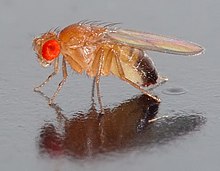Drosophila melanogaster
| Drosophila melanogaster | |
|---|---|
 |
|
| Male Drosophila melanogaster | |
| Scientific classification | |
| Kingdom: | Animalia |
| Phylum: | Arthropoda |
| Class: | Insecta |
| Order: | Diptera |
| Family: | Drosophilidae |
| Genus: | Drosophila |
| Subgenus: | Sophophora |
| Species group: | Drosophila melanogaster group |
| Species subgroup: | Drosophila melanogaster subgroup |
| Species complex: | Drosophila melanogaster complex |
| Species: | D. melanogaster |
| Binomial name | |
|
Drosophila melanogaster Meigen, 1830 |
|
| External identifiers for Drosophila melanogaster | |
|---|---|
| Encyclopedia of Life | 733739 |
| ITIS | 146290 |
| NCBI | 7227 |
| Also found in: , ADW | |
Drosophila melanogaster is a species of fly (the taxonomic order Diptera) in the family Drosophilidae. The species is known generally as the common fruit fly or vinegar fly. Starting with Charles W. Woodworth's proposal of the use of this species as a model organism, D. melanogaster continues to be widely used for biological research in studies of genetics, physiology, microbial pathogenesis, and life history evolution. It is typically used because it is an animal species that is easy to care for, has four pairs of chromosomes, breeds quickly, and lays many eggs.D. melanogaster is a common pest in homes, restaurants, and other occupied places where food is served.
Flies belonging to the family Tephritidae are also called "fruit flies". This can cause confusion, especially in Australia and South Africa, where the Mediterranean fruit fly Ceratitis capitata is an economic pest.
The D. melanogaster lifespan is about 30 days at 29 °C (84 °F).
The developmental period for D. melanogaster varies with temperature, as with many ectothermic species. The shortest development time (egg to adult), 7 days, is achieved at 28 °C (82 °F). Development times increase at higher temperatures (11 days at 30 °C or 86 °F) due to heat stress. Under ideal conditions, the development time at 25 °C (77 °F) is 8.5 days, at 18 °C (64 °F) it takes 19 days and at 12 °C (54 °F) it takes over 50 days. Under crowded conditions, development time increases, while the emerging flies are smaller. Females lay some 400 eggs (embryos), about five at a time, into rotting fruit or other suitable material such as decaying mushrooms and sap fluxes. The eggs, which are about 0.5 mm long, hatch after 12–15 hours (at 25 °C or 77 °F). The resulting larvae grow for about 4 days (at 25 °C) while molting twice (into second- and third-instar larvae), at about 24 and 48 h after hatching. During this time, they feed on the microorganisms that decompose the fruit, as well as on the sugar of the fruit itself. The mother puts feces on the egg sacs to establish the same microbial composition in the larvae's guts which has worked positively for herself. Then the larvae encapsulate in the puparium and undergo a four-day-long metamorphosis (at 25 °C), after which the adults eclose (emerge).
...
Wikipedia
